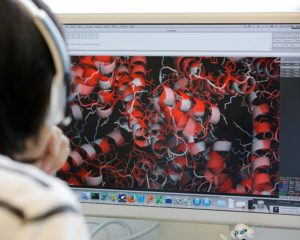Bill Gates said in a speech at the Munich Security Conference that three threats are closely related to the fate of our human species: nuclear warfare, climate change and the next global pandemic. “If we are going to prepare for the worst, we should build an arsenal.” The factory he mentioned is not referring to any guns or ammunition, but the vaccine, drugs and diagnostics.
At present, what troubles us most are the influenza virus. According to the report of the World Health Organization, although we have vaccine, seasonal influenza is still causing millions of illness and as many as half a million deaths each year globally. The reason, however, is nothing more than the long manufacturing time and limited global availability. Speaking of flu, we cannot ignore the one in Spanish in 1918 that took more than 20 million lives.
Such terrible virus is just a tiny ball with spikes under the microscope. It will use those spikes to break into human cells. Antibodies, by using those features, firmly grasp those spikes with its innate two hands. However, the rapid evolution and mutations of the virus each year make the antibodies helpless. So, new idea must be put forward in the fight against influenza, and scientists are moving to the software design.
In general, antibodies are part of the immune system. But now the computer can design antiviral protein that can do the same thing as antibody, and the effect is even better. Rather than relying on the immune system to generate an antibody protein capable of shutting down a virus like the flu, computer modeling can now help quickly create custom antiviral proteins programmed to shut down a deadly virus.
In the year of 2016, computer-engineered proteins were shown to be more effective than oseltamivir (Tamiflu). One dose of designer protein given intranasal was more effective than 10 doses of Tamiflu, a drug considered as an “essential medicine” by the WHO.
In a recently published paper in Nature Biotechnology, scientists at the Institute for Protein Design at the University of Washington demonstrated a novel way to shut down the flu: by utilizing computer model, they built a completely new kind of antiviral protein with three sticky hand. Why three? It turns out that many deadly envelope virus like influenza, Ebola and HIV-build their spike proteins out of three symmetric parts.
Antiviral proteins with three properly spaced hands may be able to symmetrically grab each part of a spike protein, leading to tight binding and better antiviral activity. The best three-handed protein was utilized into mice and it provided a complete protection against a lethal flu infection with only minimal associated weight loss.
But do not be so optimistic, many years are still needed before human trails. While this does not mean we cannot get some benefits now. By coating a strip of paper with a three-handed flue binder and applying samples on the top, scientists were stall able to detect the presence of viral surface protein event at very low concentrations. Just like a pregnancy test, a band on a test strip could indicate flu.
If a global viral pandemic like the one in 1918 strikes again, antivirus proteins might help saving millions of lives.
